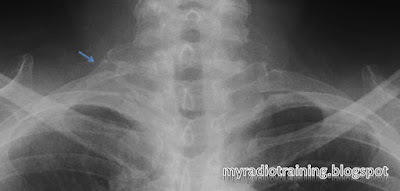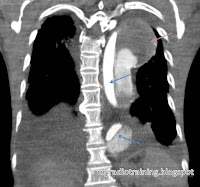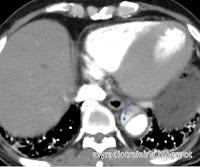 |
| Note the corresponding transverse process points caudally => Cervical origin |
Can be unilateral or bilateral.
0.5 - 8% of population*
Usually asymptomatic, but occasionally may give rise to complications.
Think about the anatomical structures that goes through the thoracic outlet, and the attachment of the scalene muscle.
Complications:
- Usually in adulthood
- Thoracic outlet syndrome
- Subclavian artery aneurysm as a result of compression
DDx:
- Hypoplastic 1st rib (rudimentary 1st rib)
- Elongated transverse process of C7
Key to differentiate from the other DDx:
(1) Check transverse process. Cervical transverse process points down, 1st thoracic transverse process points up.
(2) Check presence of joint space between the rib and the transverse process. Absent joint space means it's a elongated transverse process.
 |
| Right cervical rib. Note the transverse process pointing down. |
*Reference from: Guttentag AR, Salwen JK. Keep your eyes on the ribs: the spectrum of normal variants and diseases that involve the ribs. RadioGraphics 1999;19:1125-1142







